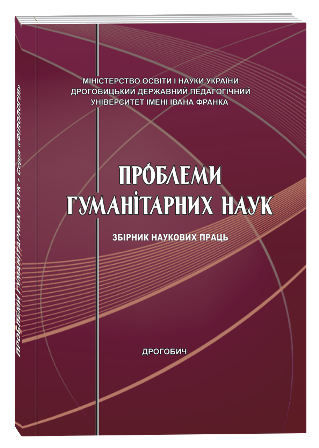DISCOURSE POSTURE (STANCE): TERMINOLOGICAL AND TRANSLATION ASPECTS
DOI:
https://doi.org/10.24919/2522-4565.2021.46.16Keywords:
discourse posture; new media; identity; position of the discourse activity subject; stance; stancetakingAbstract
The article deals with the currently urgent problem of Ukrainian linguistics – translation of the English linguistic terms into Ukrainian in general, and the use of the terminological formation “discourse posture” to refer to the phenomenon of “stance” (“position of the discourse activity subject”) in particular. The urgency of this issue is dictated, on the one hand, by the lack of a specific Ukrainian term for the “stance” nomination, and, on the other hand, by the growing popularity of this phenomenon that gains attention of an increasing number of language and discourse researchers around the world. In this work, stance is treated as a dynamic, situationallybound discursive construct, in which individual (personal) and interactive (interpersonal) planes of linguistic realization are distinguished. The article offers a brief historical reference on the research of stancetaking in linguistics. It also gives a short theoretical characteristic of this phenomenon, differentiating it from other adjacent concepts. The relevance of the chosen Ukrainian term is brought out with the help of methodology of corpus analysis, lexico-semantic, lexicographic and etymological analyses. Correspondingly, the quantitative corpus analysis “of stance” enabled determining the frequency ratio of this word in the English language. By means of the qualitative lexico-semantic analysis the main meanings of the word “stance” were detected: (1) stance as ‘a physical posture’ and (2) stance as ‘a mental position’. Furthermore, the correlation between semantics of English “stance” and Ukrainian “postava” was established. The meaning of the English word stance has also been traced in its various uses, including those related to linguistics and other humanitarian spheres. Such analysis enabled justifying the necessity of the introduction of the term “discourse posture” to the scientific circulation of Ukrainian linguistics.
References
Арутюнова Н.Д. Типы языковых значений: Оценка. Событие. Факт. Москва : Наука, 1988. 341 с.
Васютинський В.О. Психологічне підґрунтя продуктивного потенціалу індивідуалізму і колективізму. 2015. Інтернет-ресурс. URL: http://www.appsychology.org.ua/data/jrn/v9/i9/15.pdf.
Васютинський В.О. Ціннісне порозуміння українців у соціально-психологічному контексті долання бідності як стилю життя. Наукові студії із соціальної та політичної психології. 2016. Вип. 37 (40). С. 72–81.
Виноградов В.В. О категории модальности и модальных словах в русском языке. Труды Института русского языка АН СССР. 1950. Т. 2. С. 38–79.
Галуцьких І.А. Тілесність у художній прозі англійського модернізму і постмодернізму (когнітивно-семіотичні студії) : монографія / Запоріз. нац. ун-т. Запоріжжя : Кругозір, 2016. 627 с.
Кшановський О.Ч. Дієслівні форми з евіденційні значення у сучасній перській мові. Вісник Київського національного університету ім. Шевченка. Серія «Східні мови та літератури». 2015. Вип. 1 (25). С. 20–24.
Морозова О.І. Stance: позиція суб’єкта дискурсивної діяльності. Вісник Київського національного лінгвістичного університету. Серія «Філологія». Київ : Вид. центр КНЛУ, 2011. Т. 14. № 1. С. 87–93.
Плунгян В.А. Корпус как инструмент и как идеология: о некоторых уроках современной корпусной лингвистики. Русский язык в научном освещении. 2008. № 2. С. 7–20.
Приходько А.Н. Высказывание в модально-эпистемическом аспекте. Культура народов Причерноморья / Крым. научн. центр НАН Украины. 2003. № 42. C. 21–27.
Ущина В.А. Позиціювання суб’єкта в англомовному дискурсі ризику : соціокогнітивний аспект : монографія. Луцьк : Вежа-Друк, 2015. 380 с.
Шаховский В.И. Эмоции: долингвистика, лингвистика, лингвокультурология. Москва : Книж. дом «ЛИБРОКОМ», 2010. 128 с.
Якобсон Р.О. Шифтеры, глагольные категории и русский глагол. Принципы типологического анализа языков различного строя / отв. ред. Б.А. Успенский. Москва : Наука, 1972. С. 95–113.
Aikhenvald A.Y. The Art of Grammar. A Practical Guide. Oxford : Oxford University Press, 2015.
Berman R.A., Slobin D.I. Relating Events in Narrative. A Crosslinguistic Developmental Study. Hillsdale; NJ : Lawrence Erlbaum Associates, 2015. 324 p.
Biber D., Finegan E. Styles of stance in English : Lexical and grammatical marking of evidentiality and affect. Text. 1989. № 9. Р. 93–124.
Bybee J., Perkin R., Pagliuka W. The Evolution of Grammar: Tense, Aspect, and Modality in the Languages of the World. Chicago : The University of Chicago Press, 1994.
Chafe W. Evidentiality in English conversation and academic writing. Evidentially: The Linguistic Coding of Epistemology / W. Chafe & J. Nichols (Eds.). Norwood, New Jersey : Ablex Publishing Corporation, 1986. P. 261–272.
Davies B., Harré R. Positioning : The discursive production of selves. Journal for the Theory of Social Behavior. 1990. № 20 (1). P. 43–63.
Du Bois J. The stance triangle. Stancetaking in Discourse: Subjectivity, Evaluation, Interaction / R. Englebretson (Ed.). Amsterdam : John Benjamins, 2007.
Eckert P. Linguistic Variation аs Social Practice. Oxford : Blackwell, 2000. 241 p.
Englebretson R. Stancetaking in discourse: An Introduction. Stancetaking in Discourse : Subjectivity, Evaluation, Interaction / R. Englebretson (Ed.). Amsterdam – Philadelphia : John Benjamins, 2007. P. 1–25.
Ervin-Tripp S. Variety, style-shifting, and ideology. Style and Sociolinguistic Variation) / P. Eckert & J. Rickford (Eds.). Cambridge : Cambridge University Press, 2002. Р. 44–56.
Ford C., Wagner J. Interaction-based studies of language: Introduction. Pragmatics [Special Issue : Interaction-based Studies оf Language]. 1996. Vol. 6 (3). P. 277–279.
Givón T. Context as Other Minds. The Pragmatics of Sociality, Cognition and Communication. Amsterdam/Philadelphia : John Benjamins, 2005. 283 p.
Goffman E. Forms of talk. Philadelphia : University of Pennsylvania Press, 1981.
Jaffe A. Introduction: the sociolinguistics of Stance / A. Jaffe (Ed.) Stance : Sociolinguistic Perspective. Oxford : Oxford University Press, 2009. P. 3–28.
Lеmpert M. The poetics of stance. Text-metricality, epistemicity, interaction. Language in Society. 2008. Vol. 37 (4). P. 569–592.
McLeod S. Definition of Ballet Stance Aikhenvald. Demand Media. Entertainment Guide. URL: http://entertainmentguide.local.com/definition-ballet- stance-6270.h.
Martin J.R., White P.R. The Language of Evaluation: Appraisal in English. Basingstoke : Palgrave Macmillan, 2005.
Ochs E. Indexing gender / A. Duranti & Ch. Goodwin (Eds.) Rethinking Context. Cambridge : Cambridge University Press, 1993. P. 335–358.
Palmer F. R. Modality and the English Modals. London, New York : Longman, 1979.
Papafragou A. Modality: a case-study in semantic under determinacy. Amsterdam : Benjamins, 1997.
Scherer K.R. What are emotions? And how can they be measured? Social Science Information. 2005. № 44 (4). Р. 695–729.



